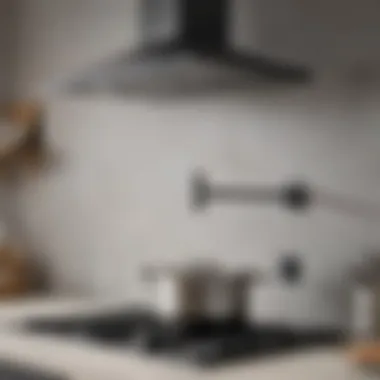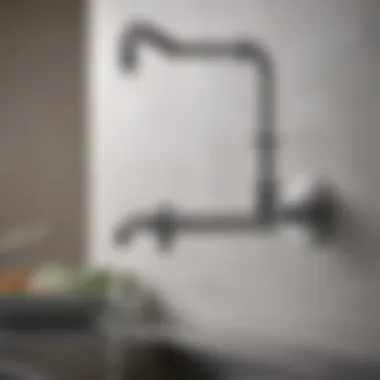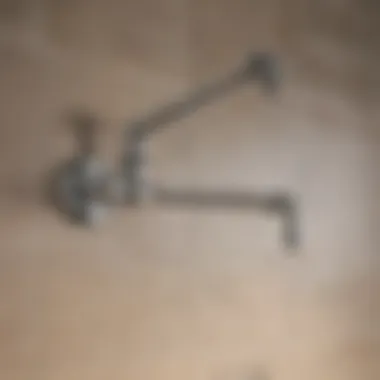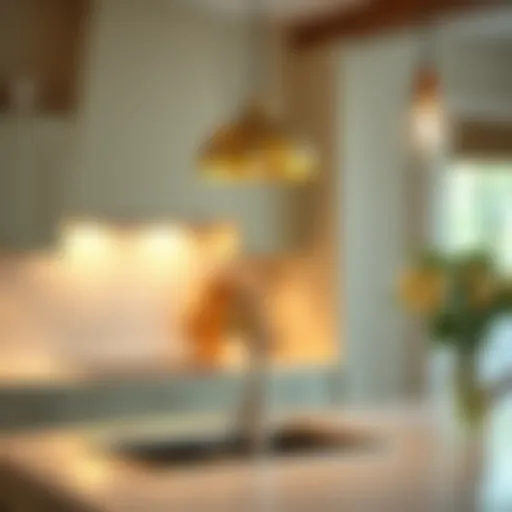Enhancing Kitchen Efficiency with a Pot Filler


Intro
The kitchen is not just a place where meals are prepared. It serves as a gathering spot, a hub of creativity, and a reflection of personal style. With modern designs focusing on both aesthetics and utility, homeowners are seeking ways to optimize their kitchen spaces. One such enhancement, which has gained popularity in contemporary homes, is the pot filler. This fixture offers both practical advantages and significant stylistic elements, making it a worthy consideration for any kitchen remodel or update.
Integrating a pot filler into your kitchen can revolutionize the way you cook, clean, and entertain. This article will shed light on the numerous benefits of adopting such a fixture, dive into various design inspirations, and discuss maintenance and upkeep practices to ensure your pot filler remains functional and appealing. By the end, you will have a clearer idea of how a pot filler can elevate your kitchen both functionally and aesthetically.
Prolusion to Pot Fillers
The presence of a pot filler in a kitchen often signals a thoughtful approach to culinary efficiency. This article explores the various dimensions that pot fillers contribute to modern kitchen design. By emphasizing both functional and aesthetic elements, homeowners can appreciate the unique benefits this fixture provides.
Definition of a Pot Filler
A pot filler is a specialized faucet that is typically mounted on the wall above the stove. Its primary purpose is to simplify the process of filling large pots with water. Unlike standard faucets, pot fillers extend their reach directly to the stovetop, thus allowing for convenient access while cooking. The construction of a pot filler often involves a double-jointed arm which allows it to swing out of the way when not in use. This design embodies practicality, ensuring that water can be accessed where it is most needed without creating additional messes or requiring heavy lifting. The availability of various styles and finishes means that homeowners can select pot fillers that align beautifully with their kitchen’s overarching aesthetic.
Historical Context
The concept of pot fillers has its roots in traditional cooking practices. Historically, these fixtures were commonly found in commercial kitchens, where chefs sought efficiency and convenience during the cooking process. Over time, pot fillers have transitioned into residential spaces, particularly in gourmet kitchens where cooking takes on a more central role. This evolution reflects a growing appreciation for both functionality and style in home design. Today, pot fillers are seen not just as tools but as sophisticated elements that enhance the overall kitchen experience.
The resurgence in popularity of pot fillers coincides with trends favoring open-concept living spaces and gourmet cooking styles. As more homeowners embrace culinary arts at home, the need for convenient and efficient cooking tools becomes essential. Therefore, the addition of a pot filler aligns with both modern needs and historical practices, bridging the gap between past and present kitchen design.
Practical Advantages of Pot Fillers
Adding a pot filler in the kitchen is not merely a trend; it is an investment in convenience, efficiency, and safety. The practical advantages of pot fillers enhance the cooking experience, making meal preparation smoother and more enjoyable. Understanding these benefits is essential for homeowners considering this feature. It doesn’t just serve a function but improves daily life in the kitchen.
Convenience in Cooking
A pot filler simplifies the process of filling large pots with water. Instead of lugging heavy pots to the sink, a pot filler brings the water directly to where it is needed. This saves time, energy, and reduces mess in the kitchen. You turn on the faucet, fill your pot right on the stove, and instantly you can start cooking.
The extended reach of pot fillers allows for flexibility in placement. It can be positioned above the cooktop, allowing for easy access when preparing pasta, boiling vegetables, or making soups. This convenience can significantly reduce the effort involved in cooking, especially when dealing with large quantities.
Moreover, pot fillers often come with a swivel feature, making it easy to maneuver around large pots, providing an added level of functionality.
Space-Saving Design
Pot fillers are designed to be compact and elegant. This is especially beneficial in kitchens with limited space. A pot filler can be mounted on the wall, freeing up valuable counter space that would typically be occupied by a traditional faucet. This allows homeowners to maximize every inch of their kitchen layout without compromising on utility.
Furthermore, the sleek design of pot fillers aligns well with various kitchen styles, from modern to traditional. This design versatility means that even in a smaller kitchen, a pot filler can blend seamlessly into the aesthetic, enhancing the overall look without overwhelming it.
Minimized Risk of Injury
When handling heavy pots filled with water, the risk of spills and accidents increases significantly. By integrating a pot filler, this risk is minimized. You avoid the need to transport heavy pots across the kitchen. Instead, water fills the pot right where it will be used, reducing the chance of accidents that can lead to burns or slips.
Additionally, pot fillers often have a long reach, which means caregivers in the kitchen can efficiently manage their workload. Whether it is boiling pasta for the family or filling pots for canning, the convenience of accessing water directly adds a layer of safety.
In summary, the practical advantages of pot fillers extend beyond mere convenience. They enhance cooking efficiency, save space, and help secure a safer kitchen environment. Whether you are a culinary enthusiast or someone who frequently hosts gatherings, these benefits will undoubtedly simplify your kitchen tasks.
Impact on Kitchen Aesthetics


The presence of a pot filler can significantly influence the overall aesthetics of a kitchen. While its primary function is to add convenience in cooking, pot fillers also serve as a design element that can elevate the style of the space. They are no longer seen merely as functional additions but are recognized for their aesthetic value. The materials, finishes, and placement of the pot filler can complement or even enhance the existing decor.
Design Versatility
Pot fillers are available in various styles and designs, making them adaptable to different kitchen themes. From sleek modern lines to ornate vintage shapes, the variety allows homeowners to select one that matches their kitchen's personality. This versatility is crucial because it ensures that the pot filler becomes a harmonious part of the space rather than an out-of-place fixture. Whether you aim for a minimalist look or prefer intricate details, there is a pot filler to fit your vision.
Enhancing Modern Styles
In contemporary kitchens, pot fillers often embody clean, geometric designs that align well with modern aesthetics. By choosing a pot filler with a streamlined appearance, homeowners can enhance the sleekness of their kitchen. These fixtures are not just about functionality; they can reflect a homeowner's personal style. They can be integrated with stainless steel appliances, quartz countertops, and even bold color schemes, contributing to a cohesive modern look.
Integration with Other Fixtures
A well-chosen pot filler also integrates seamlessly with other kitchen fixtures. For instance, if you have a farmhouse sink and a brass faucet, selecting a brass pot filler can unify the look of the kitchen. This consideration of materials and finishes creates visual harmony. When planning the kitchen layout, it’s important to think about how the pot filler will interact with the surrounding elements. The ability to coordinate with items like pendant lights and cabinet hardware enhances the kitchen's design and functionality.
The aesthetic appeal of a pot filler not only adds elegance but also reflects careful design choices that elevate the kitchen's environment.
In summary, the addition of a pot filler contributes to the kitchen's aesthetic in substantial ways. It offers design versatility, enhances modern styles, and integrates beautifully with existing fixtures. Choosing the right pot filler can transform the kitchen into a cohesive and visually appealing space.
Choosing the Right Pot Filler
Selecting the right pot filler is essential. A pot filler is not mere decoration but a functional part of your kitchen. The right choice enhances usability and significantly contributes to the kitchen style. Many homeowners overlook the selection process, focusing on aesthetics while ignoring material, finish, and design specifics. By considering these factors, you ensure that your pot filler not only works effectively but also elevates your kitchen's overall appeal.
Material Considerations
The material used for a pot filler significantly influences its durability. Common materials include brass, stainless steel, and bronze. Brass is known for its resistance to corrosion, which is a plus for kitchen environments. Stainless steel offers a sleek modern look and is often associated with contemporary designs. Bronze provides a vintage charm. Each material has different maintenance needs, influencing your long-term satisfaction with the item. Choosing a high-quality material can prevent problems like leaks or tarnishing, ensuring long-lasting use.
Finish Options
Finishes play a crucial role in the aesthetic appeal of pot fillers. They can range from polished chrome to matte black, and even brushed nickel. The finish should complement existing kitchen elements like taps and cabinetry. A cohesive look enhances the kitchen's feel. Polished finishes add a touch of elegance while matte finishes provide a more understated look. Furthermore, consider how well the finish will resist smudges or water spots, particularly in high-use areas.
Stylish Patterns and Textures
The design of your pot filler can transform an ordinary kitchen into a stylish one. From sleek lines to intricate patterns, choices abound. Consider pot fillers with decorative features that align with your kitchen's theme. Textures can add depth and interest, like ridged or knurled designs that provide a tactile experience. The right designs not only serve a functional purpose but also make a statement. Evaluation of both the form and function ensures a carefully thought-out decision that reflects personal taste.
Installation Considerations
Understanding the installation considerations when adding a pot filler to your kitchen is crucial. This process not only ensures that the pot filler operates effectively but also enhances its longevity. Proper installation can prevent potential plumbing issues and contributes to an aesthetically pleasing kitchen design.
Plumbing Requirements
Before installing a pot filler, evaluating plumbing requirements is vital. The pot filler needs direct access to the water supply, often requiring additional plumbing work.
Here are several key points to consider:
- Water line access: Ensure proximity to existing plumbing. Moving and altering plumbing lines can add to the overall cost.
- Water pressure: Verify that your household water pressure meets the filler’s specifications. Insufficient pressure can affect its performance.
- Drainage considerations: Depending on the layout, you may need to address drainage for potential leaks. Proper drainage mitigates water damage risks in your kitchen.
Placement Strategies


Choosing the right placement strategy is essential for both function and aesthetics. Pot fillers work best when they are positioned where cooking activities occur most frequently.
Consider the following:
- Near the stove: This is a common practice, allowing easy access while preparing meals. It reduces the need to carry heavy pots across the kitchen.
- Height adjustment: The pot filler should be at a height that accommodates various pot sizes. Ideally, it allows comfortable filling without awkward maneuvers.
- Accessibility: Position it within comfortable reach to enhance the cooking experience. Users should easily operate it without straining.
Professional vs. DIY Installation
When it comes to installation, homeowners often debate between professional assistance and DIY efforts. Each has its merits and drawbacks, which can dictate the success of the installation.
- Professional installation: Hiring a licensed plumber can save time and guarantee adherence to plumbing codes. Their expertise helps to prevent costly mistakes that may result from inexperience.
- DIY installation: This can be more budget-friendly and can provide a sense of accomplishment. However, it requires a proper understanding of plumbing and puting tools to ensure a successful outcome.
Ultimately, the choice between professional help or DIY will depend on your comfort level with plumbing tasks and your overall design goals.
"Proper installation is not merely about functionality; it emphasizes the importance of aesthetic integration in your kitchen layout."
In summary, considering the installation aspects of a pot filler will lead to a more streamlined and efficient kitchen setup. From plumbing requirements to thoughtful placement strategies, these elements contribute to both the performance and look of your kitchen.
Maintenance of Pot Fillers
Effective maintenance of pot fillers is crucial for ensuring their long-term functionality and appearance. Regular upkeep not only prolongs the lifespan of the fixture but also enhances the overall kitchen experience. Homeowners should prioritize cleanliness and provide attention to minor issues before they evolve into significant problems. This section will outline essential cleaning recommendations and common troubleshooting methods to keep your pot filler in excellent condition.
Cleaning Recommendations
Keeping your pot filler clean is necessary for both aesthetics and functionality. The installation of these fixtures often implies a regular flow of water, leading to potential stains and mineral buildup. Here are some practical cleaning tips:
- Use Mild Detergent: A gentle dish soap mixed with warm water works best. Avoid harsh chemicals as they can damage the surface finishes.
- Soft Cloth Wipe Down: Regularly wipe down the spout and handle with a soft cloth to remove any splashes or stains. This should become part of your routine after cooking.
- Descaling Solutions: For hard water areas, a descaling solution can help dissolve mineral deposits. Apply it as directed on the product label.
- Avoid Abrasive Cleaners: Steer clear from using scouring pads or abrasive cleaners that may scratch the surface of your pot filler.
Implementing these simple cleaning practices can prevent buildup, maintain the appearance of your pot filler, and ensure the water flow remains unobstructed.
Troubleshooting Common Issues
Despite the reliability of pot fillers, issues can arise. Identifying and addressing these problems early can save time and resources. Here are some common issues and their resolutions:
- Leaking: If you notice water drips from the base or spout, it may indicate a worn washer or cartridge within the faucet. Replacing these components is often a straightforward repair.
- Low Water Pressure: Reduced water flow could be attributed to mineral buildup inside the spout or an obstruction in the plumbing. Regular cleaning can mitigate this issue.
- Stiff Handle Movement: If the handle feels stiff, lubrication may be required. Use silicone-based lubricant around the handle base, ensuring it does not come into contact with the kitchen surface.
- No Flow: Should water fail to come out entirely, check the valve connection to ensure it is fully opened. If the problem persists, consult a plumbing professional.
By being proactive in maintenance and addressing issues as they arise, homeowners can maximize the practical benefits of their pot filler and enjoy a more efficient cooking environment.
"Regular maintenance of your pot filler not only enhances its functionality but also maintains the aesthetic appeal of your kitchen."
Maintaining your pot filler shouldn’t feel overwhelming. Awareness and regular attention can ensure this kitchen fixture remains functional and stylish for years to come.
Cost Considerations
Evaluating the financial implications of adding a pot filler is pivotal in making an informed decision. The cost analysis encompasses not just the upfront expenditure but also the long-term financial benefits associated with this addition. A pot filler can enhance cooking efficiency, which may indirectly lead to cost savings over time. Understanding both budgeting and long-term value is necessary for homeowners contemplating this investment.
Budgeting for Your Pot Filler


When planning for a pot filler, it is crucial to establish a clear budget. The initial cost of a pot filler generally ranges from a few hundred to over a thousand dollars, depending on the brand, materials, and features chosen. Factors to consider when budgeting include:
- Material Quality: Stainless steel, brass, and bronze are common materials. Each varies in price, durability, and aesthetic appeal.
- Installation Costs: Professional installation can add to your budget. Assess if you can undertake a DIY project or if hiring a plumber is necessary.
- Accessories and Features: Some pot fillers come with additional features, such as pull-down mechanisms or additional spouts, which can raise the overall cost.
Considering these elements will help in establishing a realistic financial plan.
Long-Term Value Analysis
Investing in a pot filler should also include an analysis of long-term value. Here are several aspects to consider:
- Increased Home Value: A well-installed pot filler can boost the overall appeal of a kitchen, potentially increasing property value.
- Enhanced Functionality: The convenience of easily accessing water directly from the stove can improve cooking efficiency, making it a practical choice for avid cooks.
- Durability and Maintenance Costs: Quality pot fillers may last many years, requiring minimal maintenance. Evaluate potential repairs or replacements over time to gauge the accumulated cost.
"A pot filler not only serves a functional purpose but also complements the overall aesthetic of a kitchen, ultimately delivering both immediate and enduring value."
Case Studies: Successful Implementations
Examining case studies of pot fillers in various kitchen designs illuminates their versatility and practical benefits. These real-world examples showcase how pot fillers enhance not just functionality, but also the overall kitchen atmosphere.
Contemporary Kitchen Designs
In contemporary kitchens, pot fillers serve as a blend of style and utility. Designers often choose sleek, modern pot fillers that complement the clean lines and minimalist aesthetics prevalent in today’s homes. The addition of a pot filler can minimize countertop clutter. This is especially beneficial in an open-concept space where the kitchen flows into the living or dining area.
Consider a scenario where a homeowner incorporated a Brizo pot filler that features a high-arc spout. The strategic placement above the stove allows easy access to water for cooking without needing to move large pots across the kitchen. This simple but effective design improves workflow significantly.
Moreover, a pot filler can act as a focal point in a contemporary design. When matched with high-end finishes like polished chrome or matte black, it can elevate the kitchen’s visual appeal. Homeowners have noted that the presence of a pot filler enhances not only practicality but also aesthetics, creating a striking visual statement that impresses guests.
Traditional Kitchen Settings
Traditional kitchens embrace a different design philosophy, where pot fillers integrate seamlessly into wooden cabinetry and vintage-style appliances. Here, options like the Kohler pot filler with classic detailing can provide both convenience and charm. The rich finish of the pot filler often complements the warmer tones of traditional woodwork.
In a case where homeowners opted for a Delta pot filler in a rustic kitchen, the result was a harmonious blend of style and efficiency. The pot filler was installed above a classic cast iron stove, providing immediate access to water, which is essential for a space focused on hearty meals and family gatherings.
Furthermore, the traditional design enhances the nostalgic feeling of cooking shared meals. As families gather in the kitchen, the pot filler’s presence signifies readiness and fosters an inviting environment.
"A pot filler is not just a convenience; it represents a lifestyle choice, invoking feelings of togetherness while providing practical benefits."
In summary, both contemporary and traditional kitchens showcase the successful implementation of pot fillers. Each design not only fulfills functionality but also enriches the cooking experience in unique ways.
Ending
In concluding this exploration of pot fillers, it is clear that these fixtures can offer significant advantages to both functionality and aesthetics within modern kitchens. The integration of a pot filler addresses practical needs, such as enhancing cooking convenience and minimizing strain on the user. This can make cooking a more pleasant experience, especially when used frequently.
The role of pot fillers also extends beyond practical usage. Their design versatility often attracts the attention of homeowners and interior design enthusiasts. Whether incorporated into a contemporary or more traditional setting, pot fillers can elevate a kitchen’s visual appeal.
Moreover, the considerations for installation and maintenance are straightforward enough to ensure that this feature can be added without excessive complication. Plumbing knowledge is beneficial, yet many homeowners find the installation manageable, whether opting for professional help or DIY approaches.
It is equally important to look at the long-term benefits associated with pot fillers. These fixtures can be an investment in comfort and efficiency and may even increase the value of the home.
Final Thoughts on Pot Fillers
Ultimately, pot fillers are more than just a trend. They represent a shift in how we approach kitchen design and functionality. By taking into account the individual needs and styles, homeowners can enhance their spaces in a way that is both practical and aesthetically pleasing. As cooking continues to be a focal point in our homes, adding a pot filler might indeed be one of the best decisions to improve kitchen efficiency and beauty.
"A pot filler is not merely a cooking tool; it symbolizes an elevated approach to culinary art and home design."
In summary, whether for practical reasons or personal preference, the decision to incorporate a pot filler speaks to a broader commitment to enhancing the kitchen experience.







